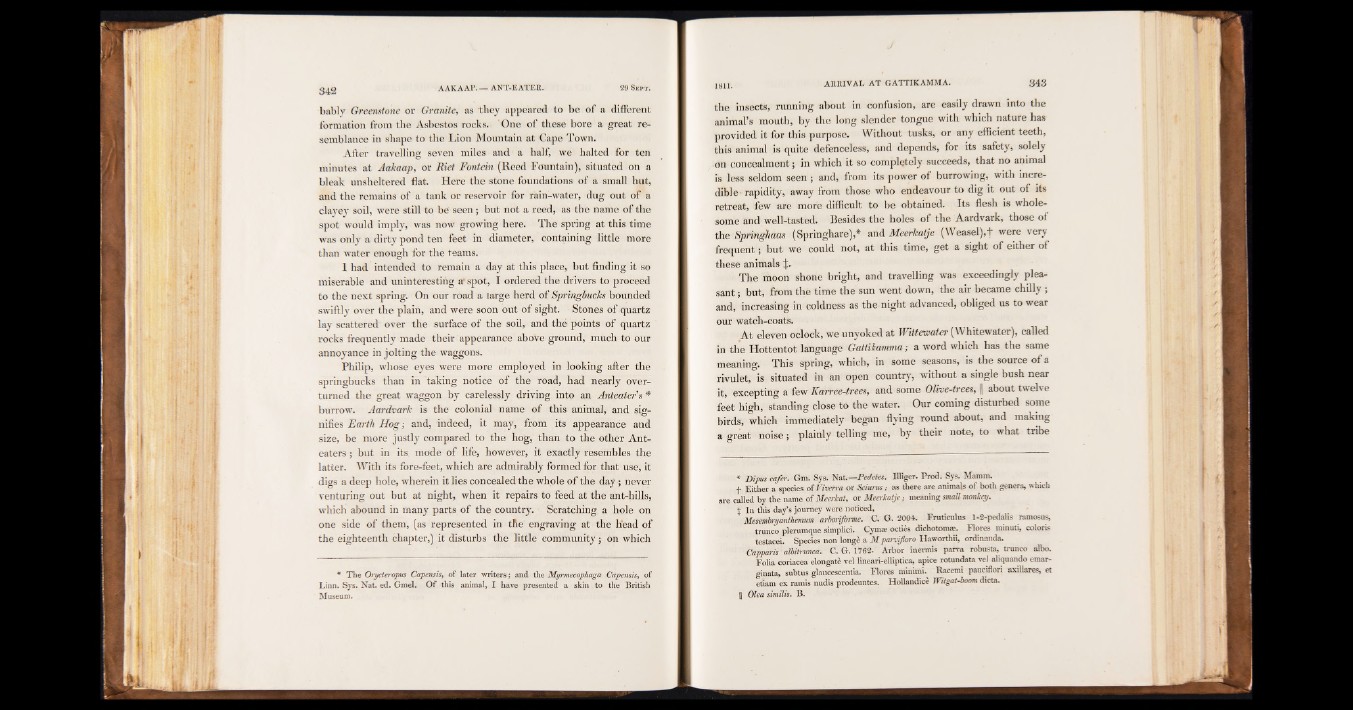
bably Greenstone or Granite, as they appeared to be of a different
formation from the Asbestos rocks. One of these bore a great resemblance
in shape to the Lion Mountain at Cape Town.
After travelling seven miles and a half, we halted for ten
minutes at Aakaap, or Riet Fontein (Reed Fountain), situated on a
bleak unsheltered flat. Here the stone foundations of a small hut,
and the remains of a tank or reservoir for rain-water, dug out of a
clayey soil, were still to be seen ; but not a reed, as the name of the
spot would imply, was now growing here. The spring at this time
was only a dirty pond ten feet in diameter, containing little more
than water enough for the teams.
1 had intended to remain a day at this place, but finding it so
miserable and uninteresting a spot, I ordered the drivers to proceed
to the next spring. On our road a large herd of Springbucks bounded
swiftly over the plain, and were soon out of sight. Stones of quartz
lay scattered over the surface of the soil, and thé points of quartz
rocks frequently made their appearance above ground, much to our
annoyance in jolting the waggons.
Philip, whose eyes were more employed in looking after the
springbucks than in taking notice of the road, had nearly overturned
the great waggon by carelessly driving into an Anteater's *
burrow. Aardvark is the colonial name of this animal, and signifies
Earth Hog ; and, indeed, it may, from its appearance and
size, be more justly compared to the hog, than to the other Ant-
eaters ; but in its mode of life, however, it exactly resembles the
latter. With its fore-feet, which are admirably formed for that use, it
digs a deep hole, wherein it lies concealed the whole of the day ; never
venturing out but at night, when it repairs to feed at the ant-hills,
which abound in many parts of the country. Scratching a hole on
one side of them, (as represented in the engraving at the head of
the eighteenth chapter,) it disturbs the little community ; on which
* The Orycteropus Capensis, of later writers; and the Myrmecophaga Capensis, of
Linn. Sys. Nat. ed. Gmel. Of this animal, I have presented a skin to the British
Museum.
the insects, running about in confusion, are easily drawn into the
animal’s mouth, by the long slender tongue with which nature has
provided it for this purpose. Without tusks, or any efficient teeth,
this animal is quite defenceless, and depends, for its safety* solely
on concealment; in which it so completely succeeds, that no animal
is less seldom seen; and, from its power of burrowing, with incredible
rapidity, away from those who endeavour to dig it out of its
retreat, few are more difficult to be obtained. Its flesh is wholesome
and well-tasted. Besides the holes of the Aardvark, those of
the Springhaas (Springhare),* and Meerkatje (Weasel),f were very
frequent; but we could not, at this time, get a sight of either of
these animals Jw
The moon shone bright, and travelling was exceedingly pleasant
; but, from the time the sun went down, the air became chilly ;
and, increasing in coldness as the night advanced, obliged us to wear
our watch-coats.
At eleven oclock, we unyoked at Wittewatcr (Whitewater), called
in the Hottentot language Gattiiamma> a word which has the same
meaning. This spring, which, in some seasons, is the source of a
rivulet, is situated in an open country, without a single bush near
it, excepting a few Karree-trees, and some Olive-trees, || about twelve
feet high, standing close to the water. Our coming disturbed some
birds, which immediately began flying round about, and making
a great noise; plainly telling me, by their note, to what tribe
* Dipus cafer. Gm. Sys. N a t—Peietes. Illiger. Prod. Sys. Hamm,
f Either a species of Viverra or Sciurus ; as there are animals of both genera, which
are called by the name of Meerkat, or Meerkatje ; meaning small monkey.
j In this day’s journey were noticed,
Mesembryanthemum arboriforme. C, G. 2004.. Fruticulus 1-2-pedalis ramosus,
trunco plerumque simplici. Cymae octiès dichotomy. Flores minuti, colons
testacei. Species non longè a M parvifloro Haworthii, ordinanda.
Capparis albitrunca. C. G. 1762. Arbor inermis parva robusta, trunco albo.
Folia coriacea elongatè vel lineari-elliptica, apice rotundata vel aliquando emarginata,
subtus glaucescenlia. Flores minimi. Racemi pauciflori axillares, et
etiam ex ramis nudis prodeuntes. Hollandicè Witgat-boom dicta.
|J Olea similis. B.